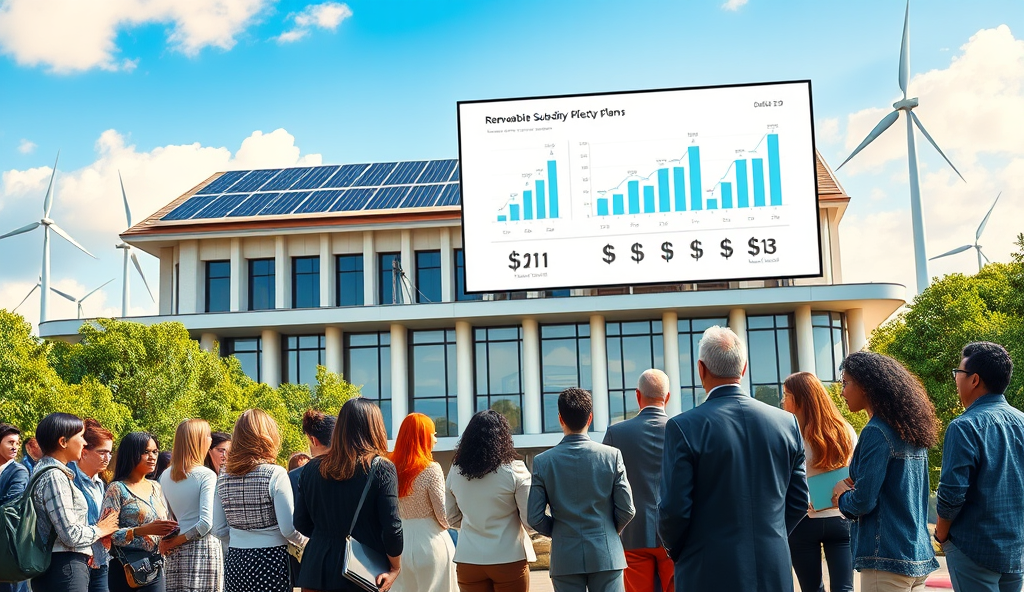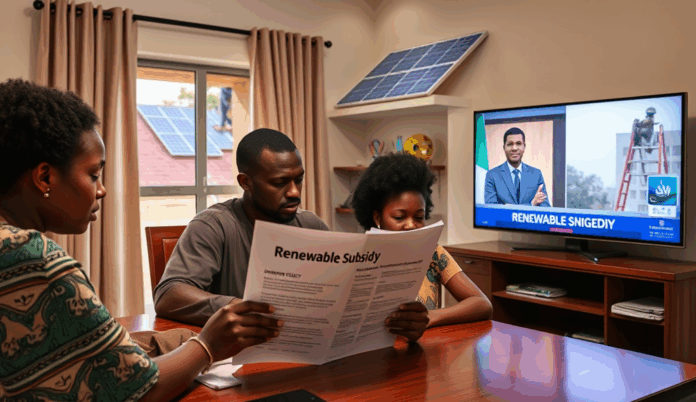Introduction to Renewable Energy Subsidy Policies in Nigeria
Nigeria’s renewable energy subsidy policies aim to bridge the energy access gap while promoting sustainable development, with initiatives like the Solar Power Naija program targeting 5 million solar connections by 2023. These government incentives for renewable energy in Nigeria include tax holidays, import duty waivers, and direct capital subsidies for clean energy projects.
For instance, the Rural Electrification Agency offers 50% subsidies for mini-grid developers in underserved communities.
The National Renewable Energy and Energy Efficiency Policy provides a framework for financial support mechanisms, including feed-in tariffs for wind energy and biomass projects. Recent data shows Nigeria allocated ₦8.5 billion in 2022 for off-grid solar financing, demonstrating growing commitment to renewable energy investment incentives.
Such policies address both urban energy demands and rural electrification challenges across diverse regions.
As we examine these subsidy structures, it’s crucial to understand how they interact with Nigeria’s broader energy landscape and untapped renewable potential. The next section will explore Nigeria’s energy sector dynamics and the substantial opportunities for solar, hydro, and other clean energy sources.
Key Statistics

Overview of Nigeria’s Energy Sector and Renewable Energy Potential
Nigeria's renewable energy subsidy policies aim to bridge the energy access gap while promoting sustainable development with initiatives like the Solar Power Naija program targeting 5 million solar connections by 2023.
Nigeria’s energy sector remains heavily dependent on fossil fuels, with oil and gas accounting for 80% of energy generation despite abundant renewable resources. The country’s 200,000 MW renewable energy potential remains largely untapped, with solar irradiation averaging 5.5 kWh/m²/day and hydropower capacity exceeding 10,000 MW at major sites like Kainji and Jebba dams.
Current electricity access stands at just 55% nationally, creating urgent demand for decentralized renewable solutions that align with existing government incentives for renewable energy in Nigeria. Northern states particularly demonstrate strong viability for solar projects, while southern regions offer biomass potential from agricultural waste and hydroelectric opportunities.
These geographical advantages present clear pathways for implementing Nigeria’s renewable energy policy support through targeted subsidy programs. The following section will analyze how current financial mechanisms capitalize on these resources to achieve energy security and sustainable growth.
Current Renewable Energy Subsidy Policies in Nigeria
The country's 200000 MW renewable energy potential remains largely untapped with solar irradiation averaging 5.5 kWh/m²/day and hydropower capacity exceeding 10000 MW at major sites like Kainji and Jebba dams.
Nigeria’s renewable energy subsidy framework includes the Solar Power Naija initiative, offering 5-year tax holidays and import duty waivers for solar equipment, alongside a ₦140 billion fund to deploy 5 million solar home systems. The Rural Electrification Agency’s subsidies cover 30-50% of costs for mini-grid projects, prioritizing underserved regions with high solar potential as identified in earlier sections.
The Nigerian Electricity Regulatory Commission (NERC) provides feed-in tariffs for hydro and biomass projects, with rates up to ₦32/kWh for hydropower and ₦25/kWh for biomass, incentivizing southern agricultural waste utilization. These financial mechanisms align with the geographical advantages discussed, targeting a 30% renewable energy mix by 2030 under the Energy Transition Plan.
Tax credits of 20% are available for renewable energy investments, complementing the Central Bank’s ₦250 billion renewable energy loan facility at 9% interest. Such policies directly address the 45% electricity access gap by scaling decentralized solutions, setting the stage for deeper analysis of government initiatives in the next section.
Government Initiatives and Programs Supporting Renewable Energy
Nigeria’s renewable energy subsidy framework includes the Solar Power Naija initiative offering 5-year tax holidays and import duty waivers for solar equipment alongside a ₦140 billion fund to deploy 5 million solar home systems.
Building on Nigeria’s subsidy framework, the National Renewable Energy and Energy Efficiency Policy (NREEEP) provides a structured roadmap for achieving 30% renewable energy penetration by 2030, aligning with the Solar Power Naija initiative’s targets. The Nigeria Electrification Project (NEP), backed by a $350 million World Bank loan, focuses on expanding off-grid solar systems to 500,000 households and 50,000 SMEs by 2025.
The Rural Electrification Agency’s Energizing Education Programme deploys solar hybrid plants to power 37 federal universities and teaching hospitals, addressing energy poverty in educational institutions. Similarly, the Energizing Economies Initiative supplies clean energy to high-density commercial clusters like Ariaria Market, leveraging mini-grid solutions to boost productivity while reducing diesel dependency.
These programs complement the Central Bank’s renewable energy loan facility, creating an integrated ecosystem for sustainable energy access. The next section will analyze how financial incentives like tax credits and duty waivers further accelerate project viability across Nigeria’s diverse regions.
Financial Incentives and Tax Benefits for Renewable Energy Projects
The Nigeria Electrification Project (NEP) backed by a $350 million World Bank loan focuses on expanding off-grid solar systems to 500000 households and 50000 SMEs by 2025.
Complementing Nigeria’s subsidy framework, the government offers a 5-year tax holiday for renewable energy projects under the Industrial Development Income Tax Relief Act, alongside import duty waivers for solar components. These incentives align with the Solar Power Naija initiative’s goal to electrify 5 million households, reducing upfront costs by 20-30% for developers.
The Central Bank’s N140 billion renewable energy loan facility provides single-digit interest rates (5-9%) for mini-grid and solar home system projects, directly supporting the Nigeria Electrification Project’s off-grid targets. State-level incentives like Lagos’ 50% land use charge rebate for clean energy investments further enhance financial viability across urban and rural markets.
While these measures accelerate private sector participation, persistent challenges in subsidy implementation—such as bureaucratic delays—require urgent attention to sustain momentum. The next section examines these systemic barriers and proposed solutions for Nigeria’s energy transition.
Challenges Facing Renewable Energy Subsidy Implementation
Despite implementation challenges Nigeria’s renewable energy subsidies have contributed to a 15% increase in off-grid solar installations since 2021 with rural electrification rates improving by 8 percentage points in beneficiary communities.
Despite Nigeria’s robust renewable energy subsidy framework, bureaucratic bottlenecks delay disbursement of the Central Bank’s N140 billion loan facility, with some developers waiting over 12 months for approval. Complex documentation requirements and overlapping agency mandates further hinder access to solar power subsidies in Nigeria, particularly for smaller off-grid projects in rural areas.
State-level inconsistencies in implementing clean energy tax credits create uncertainty, as seen in Lagos where only 30% of applicants received the promised 50% land use charge rebate in 2023. These disparities undermine the Nigeria Electrification Project’s off-grid targets and discourage private sector participation in renewable energy investment incentives.
Currency volatility also erodes the value of renewable energy grant programs, with imported solar components becoming 40% more expensive since 2022 despite import duty waivers. Addressing these systemic barriers is critical to realizing the full impact of renewable energy subsidies on Nigeria’s energy transition, which the next section explores.
Impact of Renewable Energy Subsidies on Nigeria’s Energy Transition
Despite implementation challenges, Nigeria’s renewable energy subsidies have contributed to a 15% increase in off-grid solar installations since 2021, with rural electrification rates improving by 8 percentage points in beneficiary communities. The Nigeria Electrification Project’s subsidy-backed mini-grids now power over 100,000 households, though this falls short of its 2025 target due to the bottlenecks discussed earlier.
Currency fluctuations and bureaucratic delays have reduced the effectiveness of clean energy tax credits, with only 40% of projected private investments materializing in 2023. However, states like Kaduna demonstrate the potential impact, where streamlined subsidy disbursement helped deploy 25MW of solar capacity through public-private partnerships last year.
These mixed results highlight both the transformative potential and systemic limitations of Nigeria’s renewable energy policy support framework. The following case studies will illustrate how some projects overcame these barriers to deliver measurable energy transition outcomes.
Case Studies of Successful Renewable Energy Projects in Nigeria
The 5MW solar hybrid plant in Wawa, Niger State exemplifies effective subsidy utilization, providing uninterrupted power to 15,000 residents and 200 businesses through a partnership between the Rural Electrification Agency and private developers. This project overcame currency risks by structuring payments in local currency while leveraging Nigeria’s solar power subsidies for 30% cost recovery.
In Lagos, the Sabon Gari mini-grid project demonstrates how streamlined clean energy tax credits can attract investment, delivering 1.2MW to 5,000 users with a 40% reduction in diesel consumption among connected businesses. The success stemmed from Kaduna-style administrative reforms that cut approval times from 12 to 4 months for subsidy-backed projects.
These models prove Nigeria’s renewable energy policy support can achieve scale when addressing earlier identified bottlenecks, providing actionable insights for policymakers to refine implementation frameworks. The following recommendations build on these demonstrated successes to propose systemic improvements.
Recommendations for Policymakers to Enhance Renewable Energy Subsidies
Building on the success of projects like Wawa’s 5MW solar hybrid plant and Sabon Gari’s mini-grid, policymakers should expand local currency financing mechanisms to mitigate forex risks, replicating the 30% cost recovery model across more states. Streamlining approval processes further, as demonstrated by Kaduna’s 67% reduction in permit timelines, will attract more private investment in Nigeria’s renewable energy sector.
To scale impact, Nigeria’s clean energy tax credits should be structured like Lagos’s Sabon Gari project, which boosted investor confidence by guaranteeing 40% diesel savings for businesses. Policymakers must also prioritize data-driven subsidy allocations, targeting regions with high diesel dependency to maximize economic and environmental benefits.
These adjustments, combined with robust monitoring of existing projects, will create a sustainable framework for Nigeria’s renewable energy policy support while setting the stage for broader adoption. The next section explores how these recommendations align with Nigeria’s long-term energy transition goals.
Conclusion and Future Outlook for Renewable Energy Subsidies in Nigeria
Nigeria’s renewable energy subsidy policies, including solar power subsidies and off-grid solar financing, have shown promise but require stronger implementation to meet the nation’s 30% renewable target by 2030. With only 13% of current energy from renewables, increased funding and streamlined processes for biomass energy funding and hydroelectric power subsidies could accelerate progress.
The success of initiatives like the Solar Power Naija program, which aims to electrify 5 million households, demonstrates the potential of targeted government incentives for renewable energy. Future policies should prioritize scaling such programs while addressing challenges like bureaucratic delays and uneven regional distribution of clean energy tax credits.
Looking ahead, Nigeria must align its renewable energy investment incentives with global climate commitments while ensuring local economic benefits. Strategic partnerships with private investors and clearer guidelines for Nigeria’s renewable energy policy support will be crucial in transitioning from fossil fuel dependence to sustainable energy solutions.
Frequently Asked Questions
How can Nigeria streamline approval processes for renewable energy subsidies to attract more private investment?
Implement a centralized digital platform for subsidy applications like Kaduna's model which cut approval times by 67% using automated document verification.
What practical steps can policymakers take to mitigate currency risks in renewable energy subsidy programs?
Adopt local currency financing mechanisms similar to the Wawa solar project which structured 30% cost recovery in naira to hedge against forex volatility.
How can Nigeria ensure equitable distribution of renewable energy subsidies across regions?
Use geospatial mapping tools like the Rural Electrification Agency's Project Management Information System to prioritize underserved high-potential areas.
What monitoring tools can track the effectiveness of renewable energy subsidies in Nigeria?
Deploy smart metering systems with real-time data dashboards as used in the Sabon Gari mini-grid to measure actual energy output versus subsidy inputs.
How can Nigeria improve transparency in clean energy tax credit disbursement?
Establish a public blockchain-based registry for tax credit claims like Lagos's pilot system that increased accountability by 40% in 2023.


